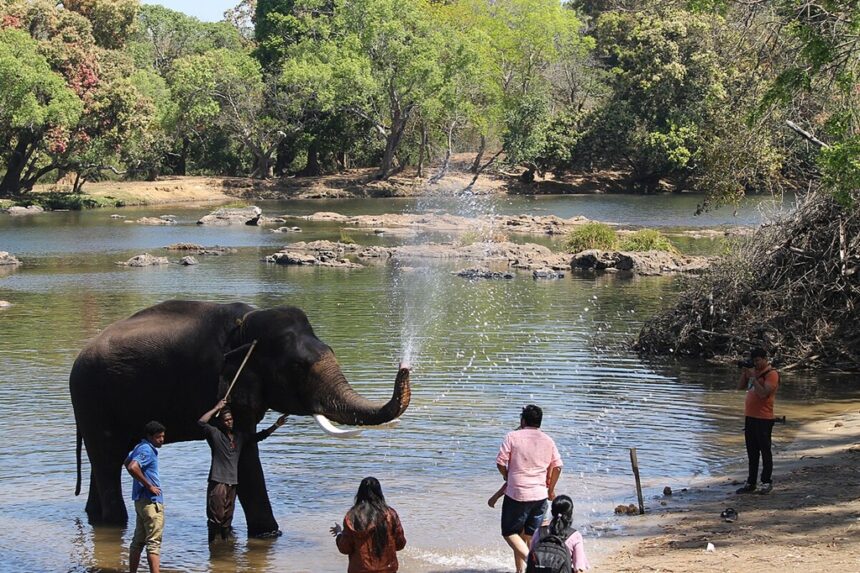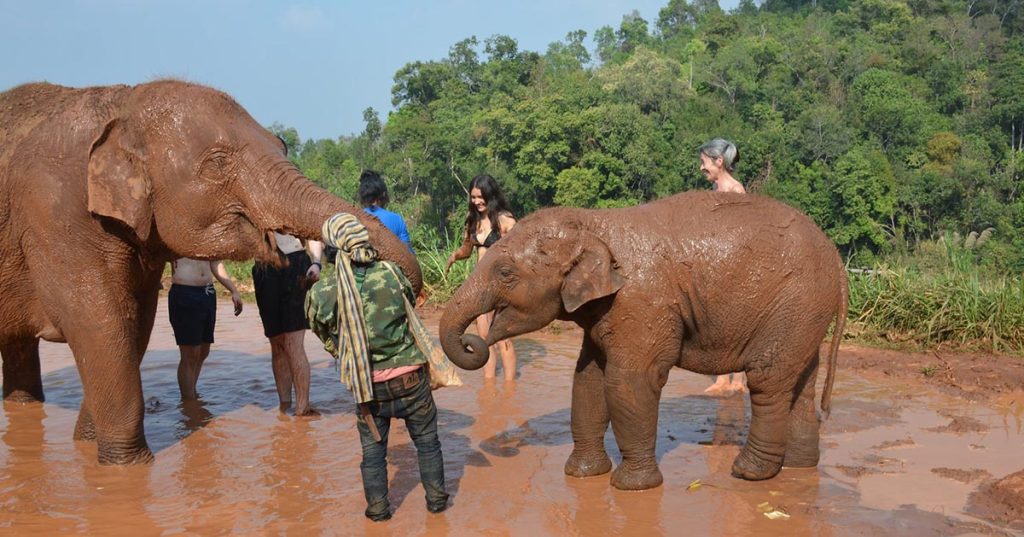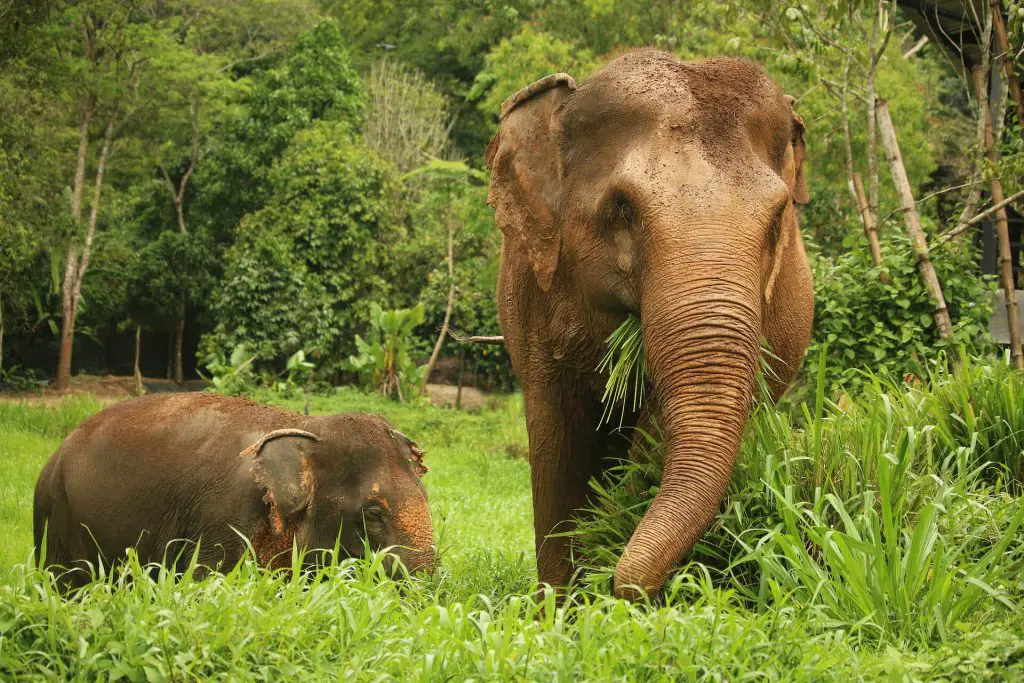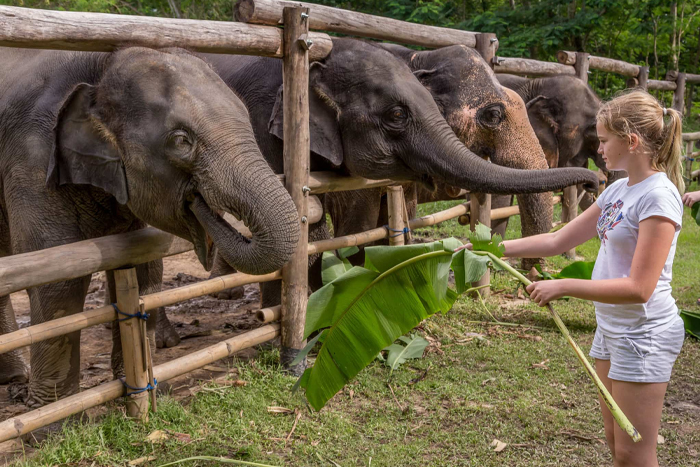Thailand is rewriting how we meet elephants. The old model of rides, circus-style shows, and staged baths is fading. In 2025, observation-first sanctuaries are growing, with more space, natural herds, and zero tricks.
A powerful example is the opening of Elephant Forest Phitsanulok, a former trekking camp turned true sanctuary with support from global advocates. Long-respected sites like Elephant Nature Park and BLES continue to draw praise, while lodges such as Elephant Hills highlight independent welfare audits and strict hands-off rules.
Still, the label “sanctuary” is not a guarantee. Some places use the word, then push touching or baby selfies.
This guide breaks down what an ethical sanctuary looks like, how to vet claims, and where to book in Chiang Mai, Sukhothai, Kanchanaburi, Phuket, and Phitsanulok. If you follow Ethical Elephant Sanctuaries in Thailand to plan a trip, you will find real change in 2025, and you will also find tourist traps that look kind but are not. Use the checklist below, a careful shortlist of ethical options, and simple steps to plan a respectful visit.
What Makes an Ethical Elephant Sanctuary in 2025?
An ethical sanctuary puts elephants first, visitors second. The visit is calm, quiet, and hands-off. You watch elephants act like elephants. No one asks them to carry people, “kiss” for photos, or paint pictures.
- No riding, no shows, no chains
- No bullhooks or sharp tools
- Hands-off viewing, not bathing or hugging
- Small groups and quiet paths
- Room to roam, shade, and water
- Natural herds and predictable daily routines
- Transparent welfare policy and independent checks
- Vet care on site or on call
Clear no riding, no shows, no chains policy
Riding puts weight on a spine not built for it. Tricks come from stress and control, not joy. Chains and bullhooks create fear. Ethical sites do not offer touching or bathing sessions. Some still allow controlled feeding, but the best visits focus on quiet observation at a safe distance. Less human contact means lower stress and more natural behavior.
Transparent care and independent audits
Look for details you can verify. You want group size limits, open viewing areas, and clear daily patterns that do not disrupt the herd. Ask for vet information, staff training methods, and how elephants form herds. Some sites publish or reference independent welfare audits. Before you book, request:
- A written welfare policy that bans riding, shows, chains, and touching
- Herd structure and history for each elephant
- Vet care schedule and emergency plan
- Guide-to-visitor ratios and group size limits
Rescue, rehab, and room to roam
Most rescued elephants come from logging, street begging, trekking, or circuses. Healing is slow and lifelong. Ethical sanctuaries fund land, nutrition, vet care, and skilled staff. Space matters. Look for natural foraging, mud wallows, pools, and shaded rest. When you visit, you should see dust bathing, grazing, slow walks, and social bonding. Those are healthy signs.
Visitor limits, quiet trails, and staff training
Small groups reduce pressure and noise. Trained guides protect distance rules and read elephant body language. Practical rules are simple: keep back, no drones, no flash, no loud voices, and follow guide cues. Mahouts should use calm, positive handling. A peaceful visit is safer for you and kinder for the herd.
Best Ethical Sanctuaries to Visit in Thailand in 2025
This shortlist reflects widely reported welfare practices and hands-off policies. Always verify current rules, since operations can change. Book direct when you can, so more of your fee supports care.
Elephant Nature Park, Chiang Mai
Known for rescue work, herd life, and observation from platforms and quiet trails. No riding, no shows, and hands-off time with guides who focus on behavior and history. Day visits are popular for first-time ethical travelers. Book well ahead, since peak season fills up. Photo tip: Use wider shots to capture natural behavior, like dust baths or gentle social greetings.
Boon Lott’s Elephant Sanctuary (BLES), Sukhothai
Praised for its small scale and deep rehab ethos, BLES keeps visitor numbers low, which creates quiet, slow days. Expect long observation windows and strong distance rules. Stays often book out months ahead. Fees support lifetime care, forest protection, and local community projects. If you want a peaceful experience with space to think, this is a strong choice.
Elephant Forest Phitsanulok, new model in 2025
Once a riding camp, now a sanctuary with no rides, no chains, and no shows. A day here often includes quiet walks on safe trails while elephants forage and interact in natural groups. Guides explain each elephant’s past and recovery plan. Check current policies and conservation goals, since the model is new and evolving. The shift shows how tourism can fund better lives.
Elephant Hills, Khao Sok region
Known for chain-free, observation-led programs and recognition in independent welfare reviews. Expect guided learning and lodge stays paired with rainforest scenery. Many travelers connect from Phuket or Surat Thani. Arrive ready for a hands-off plan with strict distance rules. Keep your focus on behavior, not selfies, and you will leave with stronger memories.
Exposed: Red Flags and Tourist Traps to Avoid
Good marketing can hide poor welfare. Read closely, ask direct questions, and trust your gut. If a place promises contact, that is your cue to skip.
Fake sanctuary signs: staged baths, circus tricks, baby selfies
Common red flags include bathing sessions for photos, painting or ball tricks, hugging or kissing baby elephants, and surprise “touch time.” Babies used for photos may be separated from their mothers. The rule is simple: if the pitch includes touching, tricks, or forced bathing, walk away.
Pricing and schedule clues that reveal exploitation
Watch for tight schedules with multiple shows per day, busloads of visitors, and tour add-ons that push close contact. That pace suits photos, not welfare. Ethical models cap group sizes, slow the pace, and budget for vet care, land, and food. Ask how your fee is spent. If answers are vague, rethink.
What the law and tour companies changed
Travel companies face rising pressure to drop low-welfare wildlife activities. Some countries and operators restrict promotion of elephant rides, shows, and direct contact. Before you buy a package, check if the operator has a clear animal welfare policy. Look for a ban on rides, tricks, and touching, plus guidance on group sizes and distance.
Latest Elephant sanctuary Thailand news that matters in 2025
Key updates include more conversions of old camps to observation-only models, fresh audits at reputable sites, and public education on hands-off visits. Elephant Forest Phitsanulok is a headline example of this shift in 2025. The trend is positive, but careful checks still matter. Policies vary by site and can change with new ownership, funding, or local rules.
Plan Your Ethical Elephant Visit: Costs, Timing, and Respect
Keep your plan simple, your schedule flexible, and your expectations humane. Elephants set the pace.
Budget, booking, and where your money goes
Day visits often range from modest fees for observation programs to higher prices for multi-day stays that include lodging, guides, and meals. Donations help cover vet bills, land leases, and rescues. Book direct when possible. Ask how funds are used, what is included, and how cancellations or storms affect the day. Good operators answer plainly.
When and where to go in Thailand
Cooler, drier months from November to February are more comfortable. Chiang Mai offers many ethical options and easier logistics for first-timers. Sukhothai is quieter and pairs well with historical stops. Kanchanaburi has river views and lush terrain.
Phuket is a common entry point for the south, and Khao Sok mixes rainforest with observation-led time. Phitsanulok is rising, thanks to the new sanctuary model. Plan extra travel time between cities, since roads and weather can slow you down.
Photo and social media rules that help elephants
- No flash and no drones
- Stay quiet and keep your distance
- Do not block paths or approach from behind
- Do not offer food or reach out to touch
- Share captions that explain hands-off ethics
- Avoid posting photos that show touching, tricks, or bathing
Pack light and act right
Wear neutral clothing, closed shoes, and sun protection. Carry a light rain layer, a refillable water bottle, and insect repellent. Follow your guide, keep voices low, and give elephants the right of way. Safety and respect go together, and both start with distance.
Quick Reference: Ethical Signs vs. Red Flags
| Ethical Signs | Red Flags |
|---|---|
| No riding, no shows, no chains | Rides, painting, ball games, “kisses” |
| Hands-off observation only | Bathing or hugging sessions |
| Small groups, quiet trails | Crowds, loudspeakers, rushed timetables |
| Clear welfare policy and audits | No policy, no third-party verification |
| Natural herds and free movement | Isolation, visible restraints, constant control |
| Vet care details available | Vague or evasive answers |
Conclusion
You can have a meaningful time with elephants without touching them. Choose sanctuaries that put welfare first, then plan a calm, hands-off visit. Use this checklist, book direct when you can, and support rescues doing hard work every day.
Real change is growing in 2025, and smart choices matter. If you track Elephant sanctuary Thailand news, share this guide with friends, and choose kindness on every trip.


















